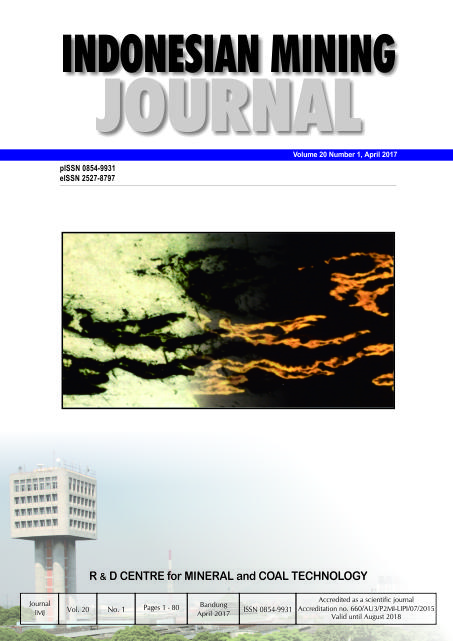EXTRACTION OF LEAD FROM GALENA CONCENTRATES USING FLUOSILICIC ACID AND PEROXIDE
DOI:
https://doi.org/10.30556/imj.Vol20.No1.2017.187Keywords:
galena, leaching, fluosilicic acid, peroxide, precipitationAbstract
A study on lead extraction from lead concentrate had been conducted. Galena is usually associated with other sulfide ores such as sphalerite.The lead concentrate was able to be extracted and purified into its metal through a leaching process using a selective solvent of fluosilicic acid (H2SiF6). Parameters used in this process include ratio (dose) of reactant (H2SiF6:H2O2), temperature (without heating; 30; 50; 70; 80; and 90°C) and particle size (-100+150#, -150+200#, -200+325, dan -325#).The best extraction was achieved using the particle size of -325 mesh. The amount of extracted lead was increased due to the rise of temperatureand dose of fluosilicic. The amount of peroxide addition was determined by its optimum influence on the lead extraction because its excess would produce PbSO4. The influence of H2SiF6 and H2O2doses was calculated using ANOVA.References
Anonymous (2015) “Reaction equation,” in HSC Chemistry 8.0. Finlandia.
Baba, A. A. and Adekola, F. A. (2013) “Solvent extraction of Pb(II) and Zn(II) from a Nigerian galena ore leach liquor by tributylphosphate and bis(2,4,4-trimethylpentyl)phosphinic acid,” Journal of King Saud University - Science, 25(4), pp. 297–305. doi: 10.1016/j.jksus.2013.07.003.
Behnajady, B., Moghaddam, J., Behnajady, M. A. and Rashchi, F. (2012) “Determination of the optimum conditions for the leaching of lead from zinc plant residues in NaCl–H2SO4–Ca(OH)2 media by the Taguchi Method,” Industrial & Engineering Chemistry Research, 51(10), pp. 3887–3894. doi: 10.1021/ie202571x.
Ghozali, I. (2011) Aplikasi analisis multivariate dengan program IBM SPSS 19. Edisi 5. Semarang: Universitas Diponegoro.
Golomeov, B., Krstev, B., Golomeova, M. and Krstev, A. (2003) “Leaching method for producing lead and elemental sulfur from domestic galena concentrates,” in X Balkan Mineral Processing Congress. Varna.
Golomeov, B., Krstev, B., Golomeova, M. and Krstev, A. (2011) “The choice between production of lead selective concentrate or recovery of lead and elemental sulphur from galenite domestic ores,” in Proceeding International Congress Machines, Technologies, Materials, pp. 11–13.
Golomeov, B., Krstev, B. and Krstev, A. (2004) “Processing of galena synthetic mixtures for producing lead and elemental sulfur,” in International Mineral Processing Conference, 9. Available at: http://eprints.ugd.edu.mk/3651/1/pbssmixostr2004.pdf.
Habashi, F. (2013) “Extractive metallurgy and national policy,” International Journal of Nonferrous Metallurgy, 2(2), pp. 31–34. doi: 10.4236/ijnm.2013.22004.
Henson, R. N. (2015) “Analysis of Variance (ANOVA),” in Toga, A. W. (ed.) Brain Mapping: an encyclopedic reference. Elsevier, pp. 477–481. doi: 10.1016/B978-0-12-397025-1.00319-5.
Idiawati, N., Triantie, A. and Wahyuni, N. (2013) “Pemisahan timbal (Pb) dalam galena dengan metode flotasi menggunakan deterjen,” POSITRON, 3(1), pp. 1–5.
Kementerian Energi dan Sumber Daya Mineral (2013) “Neraca mineral,” in Laporan Pemutakhiran Data Pusat Sumber Daya Geologi. Kementerian Energi dan Sumber Daya Mineral.
Krstev, A., Krstev, B., Mirjana Golomeova, Golomeov, B. and Krstev, D. (2012) “The choice between preparation of elemental lead or lead powder from galena concentrates from Fyrom mines,” International sciencetific journal of scientific technical, (9), pp. 53–55.
Li, G., You, Z., Sun, H., Sun, R., Peng, Z., Zhang, Y. and Jiang, T. (2016) “Separation of rhenium from lead-rich molybdenite concentrate via hydrochloric acid leaching followed by oxidative roasting,” Metals, 6(11), p. 282. doi: 10.3390/met6110282.
Wu, Z. (2010) Fundamental study on extracting lead from cerussite concentrate in methane sulfonic acid based solution. University Of British Columbia.
Zárate-Gutiérrez, R., Lapidus, G. T. and Morales, R. D. (2012) “Aqueous oxidation of galena and pyrite with nitric acid at moderate temperatures,” Hydrometallurgy, 115–116, pp. 57–63. doi: 10.1016/j.hydromet.2011.12.010.
Downloads
Published
Issue
Section
License
Indonesian Mining Journal provides immediate open access to its content on the principle that making research freely available to the public to supports a greater global exchange of knowledge.

This work is licensed under a Creative Commons Attribution-NonCommercial 4.0 International License.













